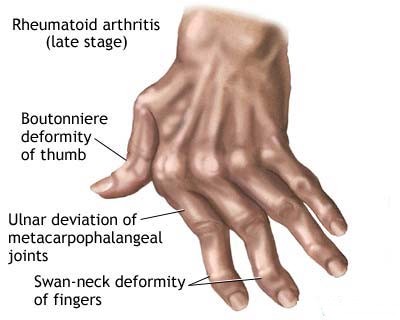Chronic arthritis may mean facing the condition every day for the rest of your life. Whether or not you control the disease depends on how you approach it.
- Lose weight. Extra pounds mean extra pressure on your joints, which can lead to more pain. Work with your doctor on a safe weight-loss program.

- Exercise wisely. Experts agree that a regular, gentle exercise program will improve your overall health and fitness without harming your joints. It will give you stronger bones and muscles, more flexible joints, more energy, better sleep, weight control, improved sense of well-being, and a greater feeling of hope and optimism. Your doctor, physical therapist, or occupational therapist can show you specific exercises for your condition, but in general, you should include flexibility, strengthening, and endurance exercises. Flexibility, or range of motion, exercises are gentle stretches and movements that keep your joints supple so you can stay up with your day-today activities. But don’t think you can substitute your daily chores for a regular exercise program. Sweeping the floor or making the beds will not work your joints fully. Strengthening exercises will improve your muscle tone and help keep your joints stable. The two most common types are easy to do practically anywhere. With isometric exercises, you repeatedly tense and relax certain sets of muscles, without moving any part of your body. Isotonic exercises require you to flex a muscle by moving a joint, for example lifting your foot while sitting in a chair. Your doctor can advise you on speed, weight, and number of repetitions. Endurance exercises will benefit your entire body, including your heart and lungs. You should start slow and easy with these, but you can build up to 30 minutes per day, three times a week. Examples of good endurance exercises are walking, swimming or water aerobics, and bicycling.

Some tips for making your exercise plan more enjoyable are:
- Find the time of day that suits you best. If a routine bores you, vary the schedule.
- Warm up by massaging your muscles or applying heat to sore joints, then begin with your flexibility exercises.
- Dress in loose comfortable clothes and well-supported shoes.
- Keep to a steady pace, one that doesn’t place too much stress on your body.
- Breathe. Try counting out loud to help you take deep breaths.
- Don’t push yourself. You don’t want to be in pain the following day, so start out easy and gradually increase your endurance. Stop if you feel pain, dizziness, or nausea.
- Set goals you can meet, and record your progress.
- Don’t skip a day, even if your arthritis flares up. Just cut back on some of the more strenuous exercises.
- Accept no excuses. Make exercise a part of your life, and it will stop feeling like work.
You can ease your arthritis pain by seeking out even ways to adapt to your condition. Explore pain management programs that teach relaxation, meditation, and guided imagery. Look for labor-saving products and devices developed with people just like you in mind. Examine everything around you; you’ll be surprised how small changes can improve the quality of your life.